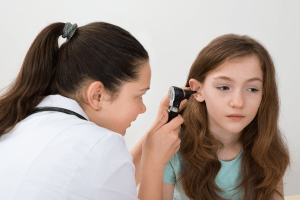In the heat of the summer, there’s no better way to cool off than jumping in the pool! Kids of all ages love to swim, but make sure they are properly supervised, wearing sunscreen, wearing an age appropriate water floatation device and young kids are within arm’s reach. While swimming is fun for all, swimmer’s ear (otitis externa) can plague even the occasional swimmer, and it’s no fun. In my own practice, I know that once temperatures start to spike I’ll be seeing lots of kids with swimmer’s ear. I’m not alone, the Centers for Disease Control and Prevention (CDC) reports that each year swimmer’s ear results in 2.4 million visits each year to the pediatrician, urgent care or emergency room. As a parent myself I know how hard it is to see your child in pain, so let’s discuss what swimmer’s ear is, how to prevent it and what you can to do treat it.
WHAT IS SWIMMER’S EAR?
By definition the Latin name for swimmer’s ear, otitis externa, means inflammation of the external auditory canal (EAC). The EAC is the passageway inside your ear leading up to the ear drum (also known as the tympanic membrane). Inflammation can be caused by a bacterial infection (swimmer’s ear), eczema and other rare infections that tend to occur in immunocompromised individuals.
Rarely swimmer’s ear can become chronic, this chronic inflammation is usually caused by continued and repeated trauma to the ear canal. How would you repeatedly injure your external auditory canal? Q-TIPS! Take it from a pediatrician, DON’T USE Q-TIPS INSIDE YOUR EARS! They may be helpful to clean your outer ear, but your inner ear is self-cleaning (that’s what ear wax is for).
WHAT CAUSES SWIMMER’S EAR?
Swimmer’s ear is caused by moisture retention and we all know that bacteria loves to grow in moist places. This moisture can accumulate from swimming but can also happen from excessive cerumen (wax), leading to a softening of the skin inside the canal (in technical terms we call this maceration). If you think your child has excessive ear wax, don’t try to clean it yourself with a Q-tip, bring them into your pediatrician where we can clean their ears gently without irritating or injuring their ear, which Q-tips often do.
Trapped moisture in the ear creates a perfect environment for bacteria to grow. Everybody normally and naturally has bacteria on their skin, which is necessary for a healthy body, but in a moist environment this bacteria can grow unchecked and cause a problem. The most common bacteria that causes swimmer’s ear is Pseudomonas (a type of bacteria that normally lives in water, soil and plants), followed by Staphylococcus (also known as staph).
WHAT ARE THE SYMPTOMS OF SWIMMER’S EAR?
Unfortunately, pain is the main symptom of swimmer’s ear. The pain is caused by the inflammation of the skin, which means that just touching or moving the ear slightly can cause a lot of discomfort. While pain is the main symptom, there may also be discharge from the ear that looks thick like pus and may have a foul odor. Additionally you may see swelling of the ear canal, this swelling along with the pus and debris (this can include ear wax, flaked off skin or scabs) may cause a temporary decrease in hearing.
If this sounds familiar, it’s probably because it sounds a little like a middle ear infection (otitis media). A middle ear infection typically accompanies a cold or congestion due to allergies and they’re also more likely to cause fever.
HOW IS SWIMMER’S EAR TREATED?
First and foremost you will want to treat your child’s pain. Giving ibuprofen or acetaminophen can be helpful, note that while this will help alleviate a symptom of swimmer’s ear, it doesn’t actually resolve the infection itself.
Second, have your child’s ear checked to be sure they actually have swimmer’s ear and not a middle ear in infection. This is an especially important distinction to make as if your child has a hole in their ear drum (perforation), it can complicate the treatment.
Dr. Matthew Brigger from the otolaryngology (sometimes known as Ear, Nose and Throat) department at Rady Children’s Hospital, usually treats swimmer’s ear using ear drops that have a combination of antibiotics and steroids. The steroids will help reduce the inflammation and the pain. “Occasionally, [in cases of swimmer’s ear] the ear canal becomes so swollen that the antibiotic drops are unable to reach the infection and a small sponge generally referred to as an otowick may need to be placed to assist in delivery of the ear drops,” states Dr. Brigger. He also recommends waiting until 1 week after resolution of pain and discharge before going back in the pool.
Long term complications are very rare from swimmer’s ear and oral antibiotics are almost never needed. Dr. Brigger reports that the most common complication is narrowing of the ear canal. To treat this complication you can seek out a referral to a pediatric otolaryngologist, sometimes known as an ear nose and throat (ENT) doctor.
WHEN SHOULD A CHILD BE REFERRED TO EAR, NOSE AND THROAT?
It is very unlikely that your child will need to see the ENT specialist for swimmer’s ear. Swimmer’s ear is something that can usually be treated successfully by your regular pediatrician. If your child’s swimmer’s ear is chronic or if there is so much debris in the canal that it needs to be cleaned out before it can be successfully treated, your pediatrician may refer to you to an ENT. Dr. Brigger and his colleagues have special tools to easily see inside the canal and safely clean it out.
HOW CAN SWIMMER’S EAR BE PREVENTED?
Dr. Brigger says, “In children who are prone to developing swimmer’s ear, it is important to ensure that no water becomes trapped in the ear canal after swimming. This is particularly important if there is a sense of water in the ear. There are a variety of effective means of which my favorites include using a hair dryer after swimming or applying over the counter swimmer’s ear prevention drops which contain a drying agent after getting out of the water. Additionally, it is important to not use Q-tips to clean the ears as earwax is our body’s natural defense against swimmers ear and Q-tips either remove or alter how our ear wax functions. If a child has persistent ear wax problems altering the normal wax pattern, they may need it removed by an ENT to allow the ear to reestablish a proper wax coating.”
Matthew Brigger, MD is a Pediatric Otolaryngologist at Rady Children's Hospital in San Diego, as well as the University of California, San Diego.




